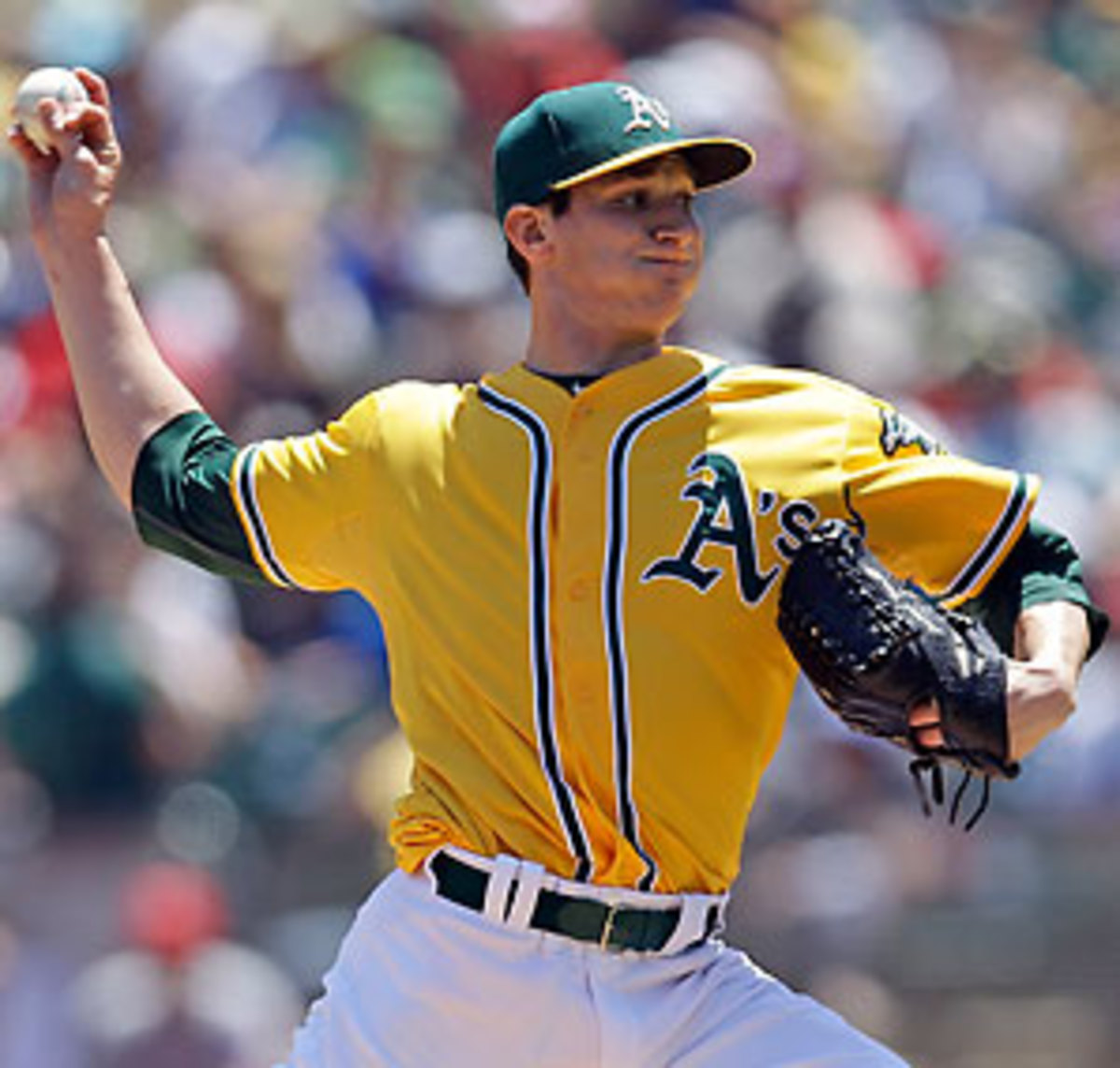Jarrod Parker and the A's circle of life

A's fans have been thrilled with Jarrod Parker, but they might not want to get too attached to him. (AP)

Jarrod Parker couldn't finish the job the way Johan Santana did, but then the stage was far smaller, with less at stake. On Monday night in front of 10,120 in Oakland Coliseum, the 23-year-old A's rookie threw seven innings of no-hit ball against the Rangers before yielding a clean up-the-middle single to Michael Young to lead off the eighth. When he began the inning, Parker's pitch count of 107 was a concern vis-à-vis his no-hit bid — his season high was 112 — but after surrendering Young's hit on his second pitch of the frame, he needed just two more pitches to escape, inducing Nelson Cruz to pop out and then getting David Murphy to ground into a double play to finish his night.
Parker is the latest in a long line of blue chip pitching prospects to enjoy their first taste of success in Oakland, though the specter of Billy Beane's seemingly endless rebuilding cycle is likely to loom over his tenure in the green and gold. He was acquired from the Diamondbacks last winter in a five-player deal that sent Trevor Cahill to Arizona, a move that came just as the latter was about to get expensive in his first year of arbitration. With their efforts to build a new ballpark in Oakland or to move to San Jose continually thwarted, and their meager attendance in the dilapidated Coliseum — which hasn't ranked higher than 12th in a 14-team league or exceeded two million since 2005 — limiting their revenue, the A's haven't been able to hold onto the players they develop.
Parker's career is fresh enough that they can hope he's the beginning of the end of that cycle. He began the year in Triple-A and was recalled on April 25. Since then, he has delivered six quality starts in eight turns, allowed more than two runs just once, and through Monday had produced a scoreless streak of 18 innings that dates back to May 23. The outing lowered his ERA to 2.40, which would rank second in the American League if he weren't 6 1/3 innings short of qualifying (a pitcher needs to average one inning per team game played). Neither his 6.5 strikeouts per nine or 4.4 walks per nine are much to write home about, but he has allowed just one home run (0.2 per nine) and benefitted from the help of the A's defense via a .250 batting average on balls in play. His 3.30 Fielding Independent Pitching mark (an estimate of his ERA based upon his peripherals) suggests a bit of regression ahead, but it's still an impressive showing — and an expected one.
Once upon a time, Parker was chosen by the Diamondbacks as the ninth pick of the 2007 draft out of an Indiana high school. From 2008 through 2012, he was promising enough to rank among Baseball America's top 100 prospects five times. His progress to the majors was slowed by Tommy John surgery following the 2009 season, but he debuted for the Diamondbacks last September and ranked 26th coming into this season.
Back when the A's were in the midst of four straight trips to the playoffs — from 2000 through 2003, the year that Michael Lewis' Moneyball was published — their success was largely driven by a trio of frontline hurlers whom they drafted in consecutive years, namely Tim Hudson (6th round, 1997), Mark Mulder (2nd overall pick, 1998) and Barry Zito (9th overall pick, 1999). By the end of the 2004 season, they were getting increasingly expensive, with free agency on the horizon, and so Beane dealt Hudson to the Braves for a three-player package that included Dan Meyer (82nd on BA's prospect list the year before) and Mulder to the Cardinals for a trio that included Dan Haren. Meyer didn't pan out, but Haren did, enjoying three strong years in Oakland (2005-2007) that included the franchise's last trip to the postseason in 2006.
Zito left for the Giants as a free agent after that season and lived not-so-happily ever-after (incidentally, the player chosen with that compensation pick, Sean Doolittle, was recalled by Oakland on Monday after converting from first base to pitching just last fall). Haren was traded to the Diamondbacks after the 2007 season in an eight-player blockbuster that brought the A's Brett Anderson and Carlos Gonzalez, among others. Joe Blanton, the 24th pick of the 2002 draft, pitched for the A's from 2004 (three appearances) to mid-2008, then was traded to Philadelphia for a three-player package that included Josh Outman. Rich Harden, a 17th round 2000 pick who pitched for the A's from 2003 to mid-2008, was traded to the Cubs nine days before Blanton was dealt, netting a four-player package that included starting third baseman Josh Donaldson.
The cycle has continued. Gio Gonzalez, a 2004 supplemental first round pick acquired from the White Sox in January 2008 as part of the package for Nick Swisher, pitched for the A's from 2008 through 2011 before being traded to the Nationals for a four-player package that includes current rotation member Tom Milone as well as righty A.J. Cole, who ranked 57th on Baseball America's list this year. Cahill, the A's second round pick in 2006, lasted three years in Oakland (2009-2011) before being dealt last winter.
Brandon McCarthy
Moneyball
